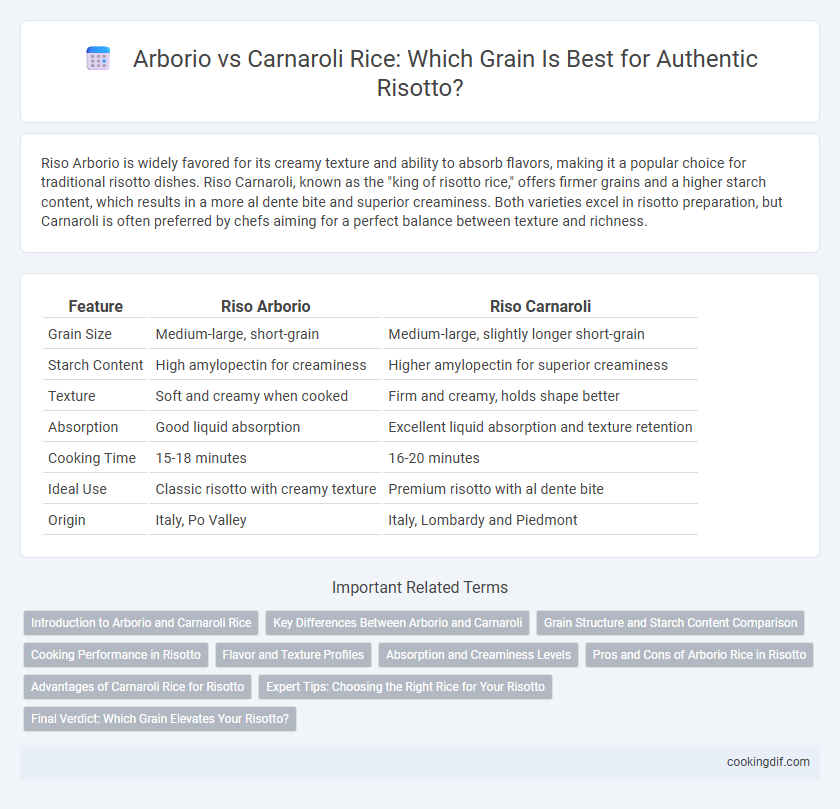Riso Arborio is widely favored for its creamy texture and ability to absorb flavors, making it a popular choice for traditional risotto dishes. Riso Carnaroli, known as the "king of risotto rice," offers firmer grains and a higher starch content, which results in a more al dente bite and superior creaminess. Both varieties excel in risotto preparation, but Carnaroli is often preferred by chefs aiming for a perfect balance between texture and richness.
Table of Comparison
| Feature | Riso Arborio | Riso Carnaroli |
|---|---|---|
| Grain Size | Medium-large, short-grain | Medium-large, slightly longer short-grain |
| Starch Content | High amylopectin for creaminess | Higher amylopectin for superior creaminess |
| Texture | Soft and creamy when cooked | Firm and creamy, holds shape better |
| Absorption | Good liquid absorption | Excellent liquid absorption and texture retention |
| Cooking Time | 15-18 minutes | 16-20 minutes |
| Ideal Use | Classic risotto with creamy texture | Premium risotto with al dente bite |
| Origin | Italy, Po Valley | Italy, Lombardy and Piedmont |
Introduction to Arborio and Carnaroli Rice
Arborio and Carnaroli are two premium Italian rice varieties widely used for risotto, each offering distinct textures and cooking properties. Arborio rice is known for its short, plump grains that release a creamy starch, providing a soft and slightly chewy texture ideal for traditional risotto dishes. Carnaroli rice features longer grains with a higher starch content and stronger grain integrity, resulting in a creamier consistency while maintaining firmness, favored by chefs for refined and complex risotto preparations.
Key Differences Between Arborio and Carnaroli
Arborio rice grains are shorter and plumper with a higher starch content, producing a creamier risotto texture, while Carnaroli grains are longer, firmer, and known for better absorption and maintaining a slightly al dente bite. Carnaroli is often preferred by chefs for its superior ability to hold shape during slow cooking, making it ideal for risottos requiring extended simmering. The choice between Arborio and Carnaroli significantly influences risotto's creaminess and texture, with Carnaroli offering more control over consistency and Arborio providing a softer, more traditional creaminess.
Grain Structure and Starch Content Comparison
Riso Arborio features short, plump grains with a high amylopectin starch content, providing a creamy texture ideal for traditional risotto dishes. Riso Carnaroli, known as the "caviar of rice," has longer, firmer grains and a higher amylose-to-amylopectin ratio, which offers superior starch release and better resistance to overcooking. The grain structure of Carnaroli ensures a slightly chewier bite while maintaining a rich, velvety consistency, making it preferred for gourmet risotto preparations.
Cooking Performance in Risotto
Riso Carnaroli outperforms Riso Arborio in risotto cooking due to its superior starch content, which provides a creamier and more stable texture throughout the cooking process. Carnaroli grains retain firmness better under prolonged heat, preventing overcooking and resulting in a balanced al dente bite. Arborio, while widely used, tends to release starch more quickly, making it ideal for shorter cooking times but less forgiving in maintaining optimal texture.
Flavor and Texture Profiles
Riso Arborio features a creamy texture and a mild, slightly nutty flavor that absorbs broths well, making it ideal for classic, comforting risottos. Riso Carnaroli offers a firmer, more al dente bite with a richer, buttery taste and superior starch content, resulting in a creamier consistency that holds shape during cooking. Choosing Carnaroli enhances the risotto's texture versatility, while Arborio provides a smoother, more delicate finish.
Absorption and Creaminess Levels
Riso Carnaroli offers superior absorption capacity and releases more starch during cooking, resulting in a creamier and silkier risotto texture compared to Riso Arborio. While Arborio grains are rounder and plumper with good absorption, Carnaroli's higher amylopectin content enhances the risotto's creaminess and keeps the grains firm yet tender. Chefs often prefer Carnaroli for its balance between creaminess and grain integrity, especially in traditional Italian risotto recipes.
Pros and Cons of Arborio Rice in Risotto
Arborio rice offers a creamy texture and releases ample starch, enhancing the richness of risotto, making it ideal for dishes requiring a smooth consistency. Its grains are shorter and plumper compared to Carnaroli, which can sometimes result in a slightly mushier dish if overcooked. While more widely available and often less expensive than Carnaroli, Arborio rice may lack some of the firm bite and subtle flavor complexity preferred by risotto connoisseurs.
Advantages of Carnaroli Rice for Risotto
Carnaroli rice, often called the "caviar of rice," boasts a higher starch content than Arborio, resulting in a creamier and more velvety risotto texture. Its firmer grains hold shape well during prolonged cooking, providing a perfect balance between creaminess and bite, ideal for traditional risotto dishes. The superior absorption properties of Carnaroli enhance flavor infusion, making it the preferred choice for chefs seeking consistent and luxurious risotto outcomes.
Expert Tips: Choosing the Right Rice for Your Risotto
Riso Carnaroli is widely preferred by chefs for risotto due to its higher starch content and firmer texture, which results in a creamier and more al dente finish. Riso Arborio, while more readily available and less expensive, tends to absorb liquids quickly and can become mushy if overcooked. Experts recommend choosing Carnaroli for a traditional, perfectly textured risotto and Arborio for quicker, everyday preparations without compromising flavor.
Final Verdict: Which Grain Elevates Your Risotto?
Riso Carnaroli is often considered the gold standard for risotto due to its higher starch content and firmer texture, which create a creamier, more al dente finish compared to Riso Arborio. Arborio rice, while more common and slightly shorter-grained, absorbs flavors well but can become mushier if overcooked, making Carnaroli preferable for precision and texture control. Choosing Carnaroli ultimately elevates your risotto with superior creaminess and a perfect bite, favored by professional chefs and risotto enthusiasts alike.
Riso Arborio vs Riso Carnaroli for Risotto Grain Infographic

 cookingdif.com
cookingdif.com